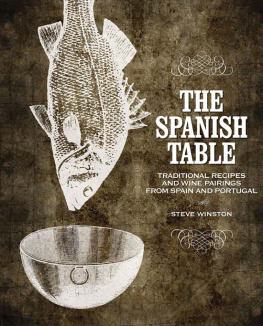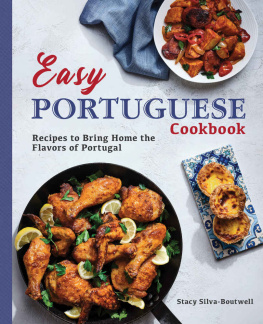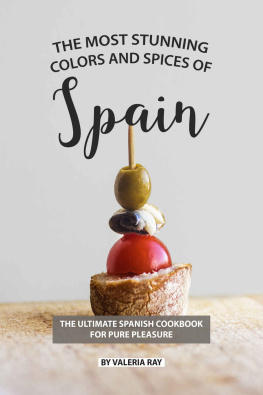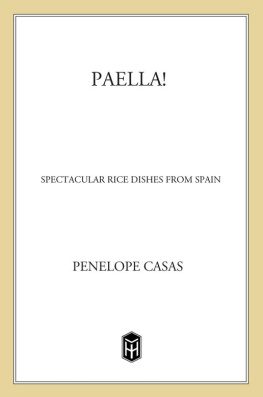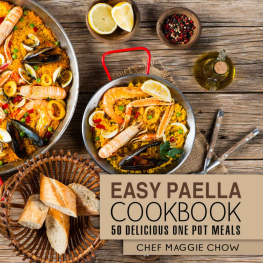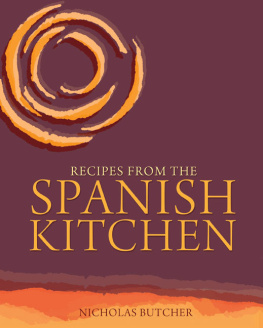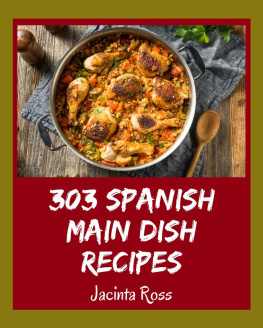All rights reserved. No part of this book may be reproduced by any means whatsoever without written permission from the publisher, except brief portions quoted for purpose of review.
1. Cookery, Spanish. @ Cookery, Portuguese. #. Wine and wine makingSpain. 4. Wine and wine makingPortugal. I. Spanish Table (Store) II. Title.
Introduction
The Spanish Table
We went to Iberia on a whim. Once we were there, we fell in love with the food and wine. That was in 1985, more than twenty years ago. We have been back at least once a year every year since. It immediately changed the way we cooked. After that first trip, the flavors we sought and the aromas we longed for were forever altered.
But we found that it was difficult after that first trip to find authentic ingredients to prepare dishes like those we remembered from our trip to Iberia or to find much variety of Spanish and Portuguese wines in the United States.
Sometimes an idea takes over your life. The idea for The Spanish Table was an idea like that. It started because we were frustrated buying ingredients for Spanish cooking. It became one of those litanies, Someone should open a store to sell these things. In 1995, it evolved into, We should open a store, when President Clinton offered federal employees early retirements.
So in September 1995, I retired from the United States Customs Service and opened the first The Spanish Table shop in Seattle. I was hoping that there were plenty of other people for whom the foods of Spain and Portugal were special enough to warrant them going out of their way to buy ingredients, utensils, and wines.
For the first two years, it seemed we were wrong. Business was slow and bills accumulated. Luckily, I had my federal pension to live on, but the shelves of groceries imported from Spain were not exactly flying out the door. Then in January 1998, Saveur Magazine placed The Spanish Table on its first Saveur 100 list. Our idea had been vindicated and The Spanish Table had been discovered. Business finally took off, and over the past several years we have opened three other shops: in Berkeley, Santa Fe, and Mill Valley, California.
Authors Note
As much as I love to read cookbooks, I am probably the worst sort of cook to write one. When I have something I want to cook, or want an idea for something to cook, I tend to consult a few cookbooks, perhaps take some cryptic notes on a scrap of paper, and start cooking.
This happens when I buy something at a farmers market or in an ethnic grocery store, or order something in a restaurant and decide it would be nice to cook something like that at home. Otherwise, I tend to just look around the kitchen for what is there and throw something together.
I have had no formal schooling in cooking. I tend not to measure things, to forget to set the timer when putting something in the oven, and to decide when to turn things over on the barbecue based on how much wine is left in the glass I poured for myself just after I put them on the grill.
When we opened The Spanish Table, people began to ask me for advice. The first year we were open, one woman actually called me up as she was making her first paella and wanted me to stay on the line coaching her until it was finished. When we finally hung up, I decided it was time to write down my paella recipe.
That was the first of many recipes I was to write down for my customers. Gradually, I began to gain nerve enough to include them in our newsletters. At first they were the obvious recipes people asked for: Paella, Clams Cataplana, and Tortilla Espaola. Then the recipes began to get a little more creative based on those nights I would wander home with a bag of products sold by The Spanish Table or samples sent to us of products someone thought The Spanish Table should sell. I might, for example, find myself asking, What can I do with a jar of cardoons? A jar of chestnuts?
In order to write recipes, I had to discipline myself. I had to measure, time, remember, and take notes. Not an easy task for someone with my attention span. I even had to stop watching television while I was cooking.
At some point, we began to assemble some of the recipes into handouts we could give customers. Still, most of the recipes, once used in a newsletter, just languished on the hard drive of whatever computer was being used when it was written.
Cleaning up the hard drive on a computer we were discarding, I was surprised to find that over the past ten years I had written down more than a hundred different recipes. So we thought, why not compile them into a cookbook?
Lets cook!
Vamos a cocinar! Vamos cozin-har!
Buena suerte
Where To Get Todo Lo Que Quieras
You can stock an Italian, French, or Chinese pantry in just about any major American city these daysbut you might have some trouble finding authentic Iberian ingredients. Unless, of course, you find your way to The Spanish Table in Seattle. Looking for the nyora peppers you need for a real Catalan romesco or a paella pan the size of your bedor the gas ring you'll need to heat it? The Spanish Table offers over 300 Spanish wines, all manner of canned goods and dried staples, a deli case full of cured meats (albeit often American made) and cheeses, olive oil, chocolate, rice, tuna, cookware...You leave the store with the same sense of connectedness to tradition that Winston replenishes every time he goes back to Spain.
Saveur 100, Jan 1998
Ingredients
The Spice Cabinet
Certain elements of aroma and flavor tend to distinguish Spanish and Portuguese cuisine from other similar cuisines. The following items contribute to that notable and tasty difference:
Saffron (azafrn/aafro)
Saffron is the stigma plucked from the blossom of a fall blooming crocus that thrives in only a few micro-climates. There are three stigmas per purple crocus flower. In Spain, it is graded by quality and certified by a Consejo Regulador. Most grocery store saffron is Sierra or "B" grade. Ask for Mancha Grade saffron, unless you use saffron powder, which, because of its increased surface area, loses its flavor and aroma more rapidly and is vulnerable to adulteration. Saffron is almost impossible to measure and is added by the pinch.
Start with a pinch of 24-48 threads, or the stigmas of eight to sixteen blossoms. The grade of the saffron and its freshness will be a contributing factor. As with all spices, smell the saffron -before using it and adjust accordingly. You will soon learn how much saffron you like-as it grows on you, it will probably be more not less.

